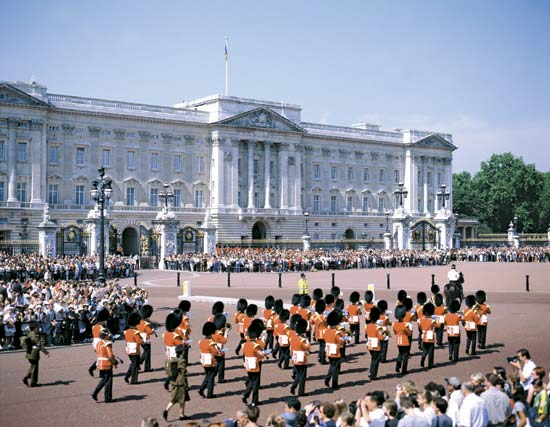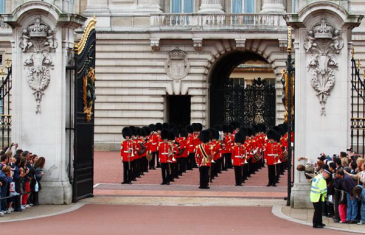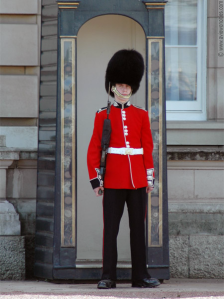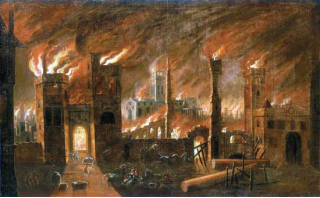План – конспект уроку з англійської мови на тему: “London - a thrilling city"
|
|



|
London – a thrilling city |
|
|
|
|
|
|
|
|
|
|
|
|
|
|
London – a thrilling city
Level – A2 (pre - intermediate)
Objectives:
- to extend the pupils’ knowledge about London and its sights;
- to stimulate the pupils’ creative imagination;
- to expand the pupils’ knowledge of English as a foreign language;
- to develop the pupils’ readiness for taking part in the process of English communication;
- to promote their intellectual curiosity;
- to activate students’ speaking skills and encourage them to use new vocabulary;
- to teach students to gain, analyze and use information.
Equipment and materials used: the map of London, posters, computers, pictures of London sights, placards with the quotations about London.
Procedure
- Greeting
Teacher: Good morning everybody! How are you today?
I’m happy to hear that you are fine and OK today. I think that our work will be very interesting and have good results.
- Warming – up
Teacher: Let us begin our today’s lesson with the quotations and you will understand the topic of our today’s lesson.
“A man who is tired of London is tired of life.”
“The more languages we know, the more times we are people.”
Teacher: I know that all of you are fond of English. You like English and understand the importance of English nowadays. Why is it necessary to study English?
Student 1: The English language is spoken by 500 million people, which is about 1/7 of the world’s population. It is estimated that 60% of the world ‘s telephone calls are made in English.
Student 2: English is the most popular language nowadays. People speak English all over the world. In Ukraine and France, in Germany and Italy, in Spain and Egypt people learn English as a foreign language. People will understand you practically everywhere if you speak English.
Student 3: English is the international language of business people, pilots and air traffic controllers, diplomats and politicians, sportsmen and students. For many people it is the key which opens the door to the world.
- Presentation and Practice
Teacher: English is very important in our life. What is a dream place of each English learner?
Student 4: I think that the dream place of each English learner is London. As for me I want to visit England very much and I’ll try to do all my best to see the sights of London.
Teacher: Of course, the heart of Britain, London, is a dream of many of us. Let us begin our acquaintance with London. Now we’ll watch the presentation you have prepared about London landmarks.
- Listening Comprehension
- Pre - listening
Teacher: You have just seen a very nice presentation of London sights. Among these sights there was one which was connected with the Royal family. It’s Buckingham Palace. Now you will listen to the text about one of the most outstanding ceremonies in London –The Changing of the Guard.
Changing of the Guard is one of the oldest and most familiar ceremonies associated with Buckingham Palace. But before listening let’s talk about the British Royal Family.
1. Which members of the British Royal Family are best known in Ukraine? Why?
2. Do you think being a member of the Royal Family is a “proper job”?
3. What sort of work do they do?
4. Would you like to belong to the Royal Family? Why?
- While – listening
Teacher: Now listen to the text and then fill in the blanks with the following words:
name, usually, process, palace, music, minutes, shows, daily, weather.
The Changing of the Guard at Buckingham Palace

The proper ______of the ceremony known as Changing the Guard is actually Guard Mounting. In this _______ a New Guard exchanges duty with the Old Guard and both Guards are drawn from one of the regiments of Foot Guards.

The handover is accompanied by a Guards band. The ____played ranges from traditional military marches to songs from musical ____and even familiar pop songs.
When The Queen is in residence, there are four sentries at the front of the building. When she is away there are two.
The Queen's Guard ______ consists of Foot Guards in full-dress uniform of red tunics and bearskins. If they have operational commitments, other infantry units such as the Brigade of Gurkhas take part instead.
Buckingham _______ - Guard Mounting takes place in the forecourt of Buckingham Palace at 11.30 am, and lasts about 45 _______. There is no Guard Mounting in very wet_______. During the autumn and winter, Guard Mounting takes place on alternate days, but it is held daily during spring and summer. Buckingham Palace is immediately adjacent to St James's Park and The Green Park.
Horse Guards Arch - the Changing of the Guard takes place _____ at 11am (10am on Sundays) and lasts about 30 minutes. It is held on Horse Guards Parade by Whitehall, which is located east of St James's Park.

- Post – listening
Teacher: Now your task is to define the following words using the dictionary:
ceremony, residence, military march, band, forecourt, handover.
- Speaking
Teacher: OK! London is famous for a lot of historical places and it is famous for its history.
Let’s come back to the history of London and remember what happened many, many, many years ago.
P1: Many, many years ago the Romans came to England. I know that they built the town on the river Thames. The name of this town was Londinium. The Romans built Londinium near thr river. Besides it the Romans built a bridge over the river. Also they built roads to other parts of Britain.
Teacher: What do you know about 1066?
P2: I would like to say that in 1066 William the Conqueror and his people came to England from Normandy in France. William became the King of London. Many of his people lived in England too. But William was afraid of English that’s why he built the Tower of London to live in it.
Teacher: What do you know about 1749? What have you found out?
P3: Until 1749 there was only one bridge over the river: London Bridge. I must say the old London Bridge looked very strange. There were houses and shops on the Bridge. In the 19th century there were many new bridges in London. Now there are more than 27 bridges over the Thames.
- Reading Comprehension
- Pre-reading activity
Teacher: What do you know about the year of 1666? What happened in that year?
I suppose it’s time to develop our reading skills. And now we shall read the text about
one great event that happened in London in 1666. But before reading let’s read new
vocabulary.
New vocabulary
|
poverty |
зубожіння, бідність |
|
plague |
чума |
|
flame |
полум’я |
|
pigeon |
голуб |
|
melt |
розчинятися, танути |
|
dry |
сухий |
|
spread |
розповсюджуватися |
|
spark |
іскра |
|
flee |
тікати, уникати |
|
ignite |
запалювати, займатися |
|
destruction |
руйнування |
|
fan |
роздмухувати |
|
burn |
горіти |
|
dock |
док |
|
sterilize |
стерилізувати |
|
favour |
користь |
|
feather |
перо |
- While –reading activity
Teacher: Read the text and put the paragraphs in the correct order.

- The Great Fire had burned down 84 churches and the old St Paul’s. However, it had also destroyed the filthy streets associated the Great Plague. The Fleet, a ‘tributary’ that flowed into the Thames, was nothing more than an open sewer associated with disease and poverty. The fire effectively boiled the Fleet and sterilized it. Slums were simply burned away. In this sense, the fire did London a favour and it was now up to the city’s authority’s to re-build and re-plan the city. This task was given to Sir Christopher Wren.
- The Great Fire of London of September 1666 was one of the most famous incidents in Stuart England. It was the second tragedy to hit the city in the space of 12 months. Just as the city was recovering from the Great Plague, the inhabitants had to flee the city once again – this time not as a result of a disease, but the result of as human accident. The Great Fire of London, arguably, left a far greater mark on the city when compared to the plague.
- The facts about the fire are simple:
The fire started in Pudding Lane The fire started in a baker’s shop owned by Thomas Farriner – who was the king’s baker His maid failed to put out the ovens at the end of the night. The heat created by the ovens caused sparks to ignite the wooden home of Farriner. In her panic, the maid tried to climb out of the building but failed. She was one of the few victims of the fire. Once it started, the fire spread quickly. The city was basically made out of wood and with September following on from the summer, the city was very dry. Strong winds fanned the flames.
- The heat created by the fire was so great that the lead roof on the old St Paul’s Cathedral melted. Many saw the lead flowing down the streets. It is said that many pigeons lost their lives as they refused to leave their nests and their wing feathers got burned and they plummeted into the fire. But the actual human casualty rate was remarkably small with possibly only 5 people dying in this fire.
- Those who could get out of the city did so. Many gathered on nearby heaths such as Hampstead. Here they were safe but they also got a good view of the destruction of the fire.
- In 1665, during the plague, the king, Charles II, had fled London. Many would have liked to have done the same and few criticized the king when he did leave for the countryside. However, in September 1666, he stayed in London and took charge of the operation to save the city. His plan was to create fire- breaks. This required knocking down perfectly good buildings but starving the fire of the wood it needed to burn. Charles also ordered that navy rations stored in the docks in the East End should be given to those who had fled the city.
Keys: 2, 3, 5, 6, 4, 1.
- Post – reading activities. Work in pairs
Teacher: Look at the pictures and find the sentences according to the pictures.
2. Why do you think the fire spread so quickly?
3. Answer the questions. If the sentence is true you write down ‘Yes’, if the sentence is false you write down ‘No’
- Because the wind was blowing
- Because the streets were dirty
- Because the houses were made of wood
- Because the streets were narrow
- Because the houses were dry after a hot summer
- Because the streets were not straight
- Writing.
Teacher: Imagine that you are in London, but your friends are at home. Write a postcard to your friends. Complete this postcard and use the words which are given in the box.
- Summing up
- Evaluation.
Teacher: So, our lesson is going to be over in a few minutes. And I must say that our lesson was very useful. You got a lot of good information about sights and history of London. Samuel Johnson was absolutely right saying, “ When a man is tired of London, he is tired of life for there is in London all that life can afford”.
Let’s sum up everything.
- What have we done today?
- What moments were the most interesting (the most difficult)?
I’m satisfied with your work and answers at the lesson. All of you got marks. Your
Today’s marks are… The lesson is over.
Good-bye!
- Home work
Teacher: At home you have to prepare your own topic “My Impressions about London”

про публікацію авторської розробки
Додати розробку
